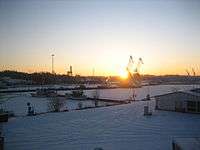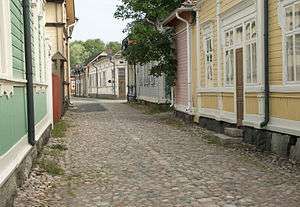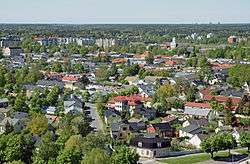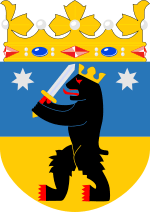Rauma, Finland
| Rauma Raumo | ||
|---|---|---|
| Town | ||
| Rauman kaupunki | ||
|
Rauma in May 2012 | ||
| ||
| Motto: Gyl Raum o ain Raum | ||
 Location of Rauma in Finland | ||
| Coordinates: 61°08′N 021°30′E / 61.133°N 21.500°ECoordinates: 61°08′N 021°30′E / 61.133°N 21.500°E | ||
| Country | Finland | |
| Region | Satakunta | |
| Sub-region | Rauma sub-region | |
| Charter | 1442-04-17 | |
| Government | ||
| • Town manager | Kari Koski | |
| Area (2011-01-01)[1] | ||
| • Total | 1,110.12 km2 (428.62 sq mi) | |
| • Land | 495.64 km2 (191.37 sq mi) | |
| • Water | 614.48 km2 (237.25 sq mi) | |
| Area rank | 102nd largest in Finland | |
| Population (2016-03-31)[2] | ||
| • Total | 39,697 | |
| • Rank | 26th largest in Finland | |
| • Density | 80.09/km2 (207.4/sq mi) | |
| • Demonym | Raumalainen (Finnish), Raumlaine (Dialect) | |
| Population by native language[3] | ||
| • Finnish | 98.2% (official) | |
| • Swedish | 0.4% | |
| • Others | 1.4% | |
| Population by age[4] | ||
| • 0 to 14 | 15.2% | |
| • 15 to 64 | 65.8% | |
| • 65 or older | 18.9% | |
| Time zone | EET (UTC+2) | |
| • Summer (DST) | EEST (UTC+3) | |
| Municipal tax rate[5] | 18% | |
| Climate | Dfb | |
| Website | www.rauma.fi | |
Rauma (Finnish pronunciation: [ˈrɑumɑ], Swedish: Raumo) is a town and municipality of ca. 39,700 (31 March 2016 )[2] inhabitants on the west coast of Finland, 92 kilometres (57 mi) north of Turku, and 50 kilometres (31 mi) south of Pori. Granted town privileges on 17 April 1442 (then under the rule of Sweden), Rauma is known for its paper and maritime industry, high quality lace (since the 18th century) and the old wooden architecture of its centre (Old Rauma, Vanha Rauma), which is a Unesco world heritage site.
History
In the 14th century, before being declared as a town, Rauma had a Franciscan monastery and a Catholic church. In 1550, the townsmen of Rauma were ordered to relocate to Helsinki, but this was successfully countered and Rauma could continue its growth.
Practically the whole wooden town of Rauma was devastated in the fires of 1640 and 1682. The wooden city centre, which is how large the town was until 1809, has approximately 600 wooden buildings. The neo-renaissance style of many of the houses is a result of prosperity brought on by seafaring. In 1897 Rauma had the largest fleet of sailing boats in Finland, totalling 57 vessels. Goods were mainly exported to Germany, Stockholm and the Baltic states. In the 1890s, Rauma got a teacher's college (a 'seminar'), which was later annexed to the University of Turku. A part of the department of education still exists in Rauma.
The name Rauma comes from the Germanic word strauma, meaning "stream".[6]
Geography
Neighborhoods and suburbs
Neighborhoods and suburbs of Rauma include: Tarvonsaari, Merirauma, Uusi-Lahti, Kappelinluhta, Paloahde, Haapasaari, Syvärauma, Kinno, Kaaro, Luostarinkylä, Impivaara, Äyhö, Uotila, Lajo, Nikulanmäki, Lensunkallio, Nummi, Pyynpää, Otanlahti, Pidesluoto, Komppi, Lonsi, Polari, Sampaanala, Paroalho, Kourujärvi, Kortela, Monna, Kourujärvi, Kodisjoki, Lappi.
Industry
After World War II, Rauma developed into an industrial city, the main industries being shipbuilding, paper and pulp mills, and metal industry. Rauma is also the fifth largest port in Finland with almost six million tonnes of shipping per year. Olkiluoto Nuclear Power Plant is located next to Rauma, in Eurajoki. Near Rauma, there is the static-inverter plant of Fenno-Skan.
Transport

Rauma is located between Turku and Pori by the national road 8 (E8). Finnish national road 12 starts from Rauma and it was extended to the port of Rauma in 2008.
A railway connection from Kokemäki is in active freight use, as there is a straight connection to the heavy industry areas and to the port of Rauma. The rail passenger traffic ended in 1988.
Satakunnan Liikenne Oy runs the local bus traffic and it has 3 lines in Rauma.[7] The hub for the local buses is located in Savila while the Long distance buses operate from Rauma bus station. The long distance buses take passengers directly to Pori and Turku and to Tampere and Helsinki with one transfer at Huittinen.[8]
The nearest airport is located in Pori. The port of Rauma serves only freight ships on frequent basis.
Culture
Rauma has its own dialect of Finnish, "Rauman giäl". The dialect inherits words from languages such as Swedish, English and German due to the seafaring past. The dialect has been diluted into mainstream Finnish in day-to-day use, but it is fairly well studied (mainly by Hj. Nortamo) and practiced as a hobby.
Rauma Maritime Museum in the Rauma Nautical School building was founded in 1999.[9]
Lace Week
Annual Lace Week has been arranged in Rauma since year 1971. During the Lace week local craftspeople arrange small exhibitions in the Old Rauma area. The Lace week culminates to the Black Lace Night, when the small boutiques are open late night, various shows and concerts are held and people dress in black lace.
Other events
- Music festival RMJ, held in Pori in 2008 and 2009.
- Classical music festival Festivo
- Jazz-happening Rauma Summer Jazz
- Creative and performing music arts festival Klustermus
- Movie festival Blue Sea Film Festival
- Blues festival Rauma Blues
Sports
Rauman Lukko is an ice hockey team that hails from Rauma, playing in Liiga. Their home arena is Äijänsuo Arena. Local football teams are Pallo-Iirot and FC Rauma. These two teams share the same home field at Äijänsuo sports centre. Sea City Storm is an American football team playing in the Finnish American Football Association's 2nd division. Fera is a women's Finnish baseball team, whose home field is the Länsi-Suomi Arena at Otanlahti sports centre. Rauma also has an own orienteering club, Rasti-Lukko, two Basketball teams known as Kaaron Roima and Rauma Basket, a rinkball team called UKP and a floorball team named SalBa.
Recreation

One popular saying goes that every family in Rauma owns a boat – this is not true, though the city has room for ca. 2,800[10] boats at its docks. People can use their own boats or water buses to get to the Kylmäpihlaja lighthouse that doubles as a hotel and recreation site. Water buses take people to Reksaari island and former garrison island of Kuuskajaskari. Both islands are in recreational use.
Consolidation of municipalities
Rauma and the surrounding municipality of Rauman maalaiskunta ("rural municipality of Rauma") were consolidated in 1993, continued in 2007 with the consolidation of municipality of Kodisjoki. The municipality of Lappi was consolidated to Rauma in 2009.
 Church of The Holy Cross
Church of The Holy Cross Tower of the Church of The Holy Cross
Tower of the Church of The Holy Cross Church of The Holy Cross
Church of The Holy Cross- The old town hall of Rauma
 Street in city centre
Street in city centre Historic buildings
Historic buildings Historic buildings
Historic buildings
International relations
Twin towns — Sister cities
Rauma is twinned with the following cities and towns:

References
- ↑ "Area by municipality as of 1 January 2011" (PDF) (in Finnish and Swedish). Land Survey of Finland. Retrieved 9 March 2011.
- 1 2 "Ennakkoväkiluku sukupuolen mukaan alueittain, maaliskuu.2016" (in Finnish). Statistics Finland. Retrieved 31 March 2016.
- ↑ "Population according to language and the number of foreigners and land area km2 by area as of 31 December 2008". Statistics Finland's PX-Web databases. Statistics Finland. Retrieved 29 March 2009.
- ↑ "Population according to age and gender by area as of 31 December 2008". Statistics Finland's PX-Web databases. Statistics Finland. Retrieved 28 April 2009.
- ↑ "List of municipal and parish tax rates in 2011". Tax Administration of Finland. 29 November 2010. Retrieved 13 March 2011.
- ↑ "Archived copy". Archived from the original on 2016-03-08. Retrieved 2011-09-16.
- ↑ "Local bus timetables" (in Finnish). Satakunnan Liikenne. Retrieved 2009-11-04.
- ↑ "Long distance bus timetables" (in Finnish). Satakunnan Liikenne. Retrieved 2009-11-04.
- ↑ Museum Archived August 10, 2011, at the Wayback Machine.
- ↑ Finnish Maritime Administration Archived April 6, 2008, at the Wayback Machine. August 19, 2008 – Boating in Finland and its economic impacts
External links
| Wikimedia Commons has media related to Rauma. |
| Wikivoyage has a travel guide for Rauma. |
- Town of Rauma – Official site
- Länsi-Suomi – The city's most widely read newspaper
- Uusi Rauma – Local biweekly free newspaper, makes also a publication in local dialect once a year.
- Radio Ramona - Local radio station
- Rauma collection in 3D Warehouse


